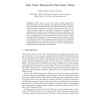Free Online Productivity Tools
i2Speak
i2Symbol
i2OCR
iTex2Img
iWeb2Print
iWeb2Shot
i2Type
iPdf2Split
iPdf2Merge
i2Bopomofo
i2Arabic
i2Style
i2Image
i2PDF
iLatex2Rtf
Sci2ools
ACCV
2010
Springer
2010
Springer
Four Color Theorem for Fast Early Vision
Recent work on early vision such as image segmentation, image restoration, stereo matching, and optical flow models these problems using Markov Random Fields. Although this formulation yields an NP-hard energy minimization problem, good heuristics have been developed based on graph cuts and belief propagation. Nevertheless both approaches still require tens of seconds to solve stereo problems on recent PCs. Such running times are impractical for optical flow and many image segmentation and restoration problems. We show how to reduce the computational complexity of belief propagation by applying the Four Color Theorem to limit the maximum number of labels in the underlying image segmentation to at most four. We show that this provides substantial speed improvements for large inputs to a variety of vision problems, while maintaining competitive result quality.
| Added | 12 May 2011 |
| Updated | 12 May 2011 |
| Type | Journal |
| Year | 2010 |
| Where | ACCV |
| Authors | Radu Timofte, Luc J. Van Gool |
Comments (0)

